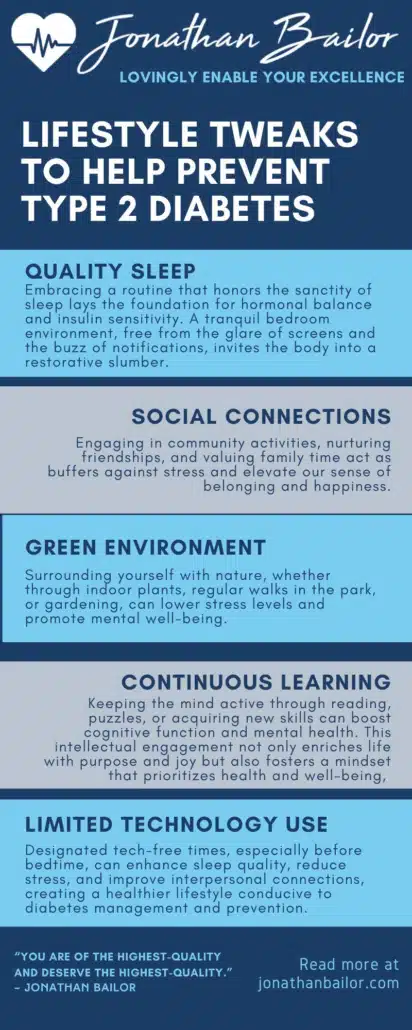18 Easy Natural Strategies to Help Prevent or Manage Type 2 Diabetes
In this Hormone Health Guide with Jonathan Bailor, we explore effective strategies for addressing the complexities of Type 2 Diabetes. Whether in prevention or management, the emphasis is on integrating natural, sustainable approaches into daily life. It’s about making small, impactful changes that yield significant health benefits over time. Managing or preventing Type 2 Diabetes requires a holistic approach that considers various aspects of well-being rather than relying on a singular solution.
Imagine transforming everyday routines into powerful tools against Type 2 Diabetes. From the foods chosen at the grocery store to how stress is managed after a long day, each decision plays a pivotal role in influencing blood sugar levels and overall well-being. It’s about crafting a lifestyle where healthy choices become second nature, fostering a sense of empowerment and control over your health.
This introductory guide is a call to action to explore these transformative strategies. By delving deeper into the forthcoming sections, you will discover the ease with which these natural methods can be adopted. The goal is not to overhaul life overnight but to introduce gradual changes that collectively forge a path toward optimal health and vitality.
Embrace this journey with an open mind and a willing spirit, and witness the unfolding of a healthier, more vibrant life. The full exploration awaits, ready to equip you with the knowledge and tools necessary to navigate the landscape of Type 2 Diabetes with confidence and grace. Share this journey on how to avoid a diabetes diagnosis, spread the word, and let’s embark on a path to wellness together.
Unveiling Pathways to Wellness: Beyond Diet and Exercise
Embarking on a journey to manage or prevent Type 2 Diabetes transcends the realms of diet and physical activity alone. It invites an exploration into the broader spectrum of lifestyle choices that significantly impact health. The essence of this exploration is to illuminate paths less traveled but equally critical in weaving the tapestry of well-being.
Here, we venture into five lifestyle adjustments that, while often overlooked, serve as vital components in nurturing a life of vitality and balance, steering clear from the shadows of Type 2 Diabetes.
1. Prioritize Quality Sleep
Embracing a routine that honors the sanctity of sleep lays the foundation for hormonal balance and insulin sensitivity. A tranquil bedroom environment, free from the glare of screens and the buzz of notifications, invites the body into a restorative slumber.
Regular sleep schedules not only rejuvenate the mind but also fortify the body’s defenses against health adversities, creating a sanctuary of wellness.
2. Foster Social Connections
The strength of our social ties profoundly influences our health trajectory. Engaging in community activities, nurturing friendships, and valuing family time act as buffers against stress and elevate our sense of belonging and happiness.
This social fabric enriches our lives, indirectly fortifying our resilience against chronic conditions.
3. Cultivate a Green Environment
Surrounding yourself with nature, whether through indoor plants, regular walks in the park, or gardening, can lower stress levels and promote mental well-being.
This connection to the earth’s rhythms also encourages mindfulness and a slower pace of life, creating a serene backdrop against which the body thrives.
4. Embrace Continuous Learning
Keeping the mind active through reading, puzzles, or acquiring new skills can boost cognitive function and mental health. This intellectual engagement not only enriches life with purpose and joy but also fosters a mindset that prioritizes health and well-being, making it easier to maintain a balanced lifestyle.
5. Moderate Technology Use
In a world where digital devices are an integral part of daily life, it is important to set boundaries around their use to benefit physical and mental health. Designated tech-free times, especially before bedtime, can enhance sleep quality, reduce stress, and improve interpersonal connections, creating a healthier lifestyle conducive to diabetes management and prevention.
In weaving these threads into the fabric of daily life, a picture emerges not just of disease prevention but of holistic well-being. These lifestyle changes, though simple, pave the way for a life where managing or preventing Type 2 Diabetes becomes a natural byproduct of living fully and mindfully. Let’s embark on this journey together, embracing these pillars of health with open arms.

Feeling Better Is Priceless, That's Why We Don't Put A Price On It!
“It’s Like A Free and Medically Valid Version of Noom and Weight Watchers Online”
~ Dr. Doctor Matthew Oleshiak, MD
Click the 'LEARN MORE' button below for free lifetime access to the fast fix program developed by Jonathan and top Ivy League Medical Doctors
LEARN MOREP.S. It's not a free trial. It's not part of the program for free. The entire program is free, forever, for real! No credit card needed.
Nourishing Foundations: Dietary Shifts for Diabetes Management
In the intricate dance of managing or preventing Type 2 Diabetes, the foods we choose to consume play a pivotal role. It’s not merely about restriction but about embracing healthy eating with a diverse palette of nutrients that work in harmony to support our body’s equilibrium. This journey into dietary transformation is an invitation to discover the profound impact of mindful eating on our well-being.
The following dietary changes, centered on nourishment and balance, offer a blueprint for those seeking to gently guide their health toward a state of renewal and vitality.
1. Embrace Healthy Fats
Incorporating a variety of healthy fats, such as those found in avocados, nuts, seeds, and olive oil, can significantly enhance insulin sensitivity and provide a stable energy source.
These nourishing lipids support cellular health and satiety, gently guiding the body toward a harmonious state where managing blood sugar becomes more intuitive.
2. Choose Low-Glycemic Index Foods
Foods with a low glycemic index release glucose slowly and steadily, helping to maintain stable blood sugar levels. Opting for legumes, leafy greens, and most low-sugar fruits can transform meals into a cascade of sustained energy without the abrupt peaks and troughs that challenge glucose control.
3. Increase Fiber Intake
Fiber acts as a bulwark in the digestive system, slowing the absorption of sugar and improving blood sugar levels. Integrating a rich tapestry of vegetables, legumes, and seeds into daily meals can enhance digestive well-being while subtly curbing the appetite, fostering a gentle path toward weight management.
The American Diabetes Association recommends a healthy diet that includes plenty of nonstarchy vegetables for diabetes prevention and diabetes care, as they help regulate blood glucose levels. The Centers for Disease Control (CDC) also recommends dietary fiber to help you manage or prevent type 2 diabetes.
4. Stay Hydrated with Healthy Beverages
Replacing sugary drinks with water, herbal teas, or infused water not only aids in maintaining optimal hydration but also reduces the intake of empty calories. This simple swap can profoundly affect blood sugar levels, weight management, and overall metabolic health.
5. Experiment with Plant-Based Proteins
Incorporating plant-based proteins from legumes, tofu, and tempeh into the diet offers a dual advantage in managing blood sugar and enhancing heart health.
This shift not only diversifies the nutrient profile of meals but also introduces a spectrum of health-promoting phytonutrients and fibers, paving the way for a vibrant, healthful eating pattern.
Embarking on this dietary journey invites a rekindling of the relationship with food, transforming it into a source of healing and vitality. These changes, rooted in the wisdom of nourishment, offer a gentle yet powerful approach to managing or preventing Type 2 Diabetes. Let this be a journey of discovery, where each meal brings you closer to balance and wellness.
Vital Movements: Physical Activities for Harmonizing Health
The journey toward managing or preventing Type 2 Diabetes is enriched and enlivened by the rhythm of movement. Physical activity, far from being a mere recommendation, serves as a bridge to a more vibrant state of health, tuning the body’s mechanisms for optimal performance. This exploration of physical activities is not a pursuit of intensity but a celebration of movement in all its forms, inviting the body to engage, energize, and heal within the cadence of daily life.
Below are four physical activity adjustments, each a step towards synchronizing the body’s natural rhythms with the melody of well-being.
1. Take Part in Water Aerobics
Water aerobics offers a low-impact, high-resistance environment ideal for enhancing cardiovascular health while minimizing joint strain. The buoyancy of water supports the body, allowing for a full range of motion that strengthens the heart, muscles, and mind.
This aquatic dance is not just an exercise but a healing ritual, inviting the body to find balance and strength in the embrace of water.
2. Explore Resistance Training
Engaging in resistance training, such as using bands, weights, or body-weight exercises, twice a week can significantly improve insulin sensitivity and muscle mass. This form of physical activity encourages the muscles to absorb blood glucose, reducing high blood sugar levels, which can help you attain a healthy weight.
It’s a dialogue between strength and endurance, crafting a narrative of empowerment and resilience.
3. Incorporate Interval Walking
Interval walking blends the simplicity of walking with the power of intensity variation, creating a dynamic exercise easily integrated into daily routines. Alternating between brisk walking and a more relaxed pace can boost cardiovascular health and burn more calories than walking at a constant speed. Indeed, interval walking can help you lower your blood sugar and lose weight.
It’s a journey within a journey, where each step is a stride towards vitality.
4. Practice Tai Chi
This ancient martial art, known for its slow and deliberate movements, harmonizes energy flow within the body. Tai Chi supports joint health, reduces stress, and improves balance and flexibility.
It’s a form of moving meditation, where the flow of movements invites calm and centers the mind in the present moment, enhancing physical and emotional well-being.
Embracing these physical activities invites a rediscovery of the joy of movement, transforming exercise from a task to a cherished part of the day. It’s an invitation to dance to the rhythm of life, where each movement is a step towards a healthier, more balanced existence. Let these activities be a guide, leading the way to a harmonious blend of health and happiness.
Inner Harmony: Mental and Spiritual Practices for Diabetes Management
In the multifaceted journey of managing or preventing Type 2 Diabetes, nurturing the garden of the mind and spirit plays a pivotal role. Beyond the realms of physical nourishment and movement lies the expansive territory of mental and spiritual well-being, a landscape rich with the potential for healing and balance.
This exploration into mental and spiritual practices is an invitation to cultivate inner harmony, fostering resilience and tranquility that radiate through every aspect of health.
Here are four practices designed to strengthen the mental and spiritual foundations, each a step towards integrating peace and mindfulness into the tapestry of daily life.
1. Engage in Daily Meditation
Carving out time each day for meditation can significantly lower stress levels, enhance emotional well-being, and improve blood sugar control. Meditation invites a deep connection with the present moment, allowing thoughts and sensations to pass without attachment and fostering a state of calm awareness.
This practice is a sanctuary, offering a retreat from the chaos of daily life, where the mind can find balance and clarity. It also helps lower blood pressure and reduce the risk of developing diabetes and heart disease.
2. Practice Gratitude Journaling
Cultivating gratitude through daily journaling shifts focus from challenges to blessings, enhancing emotional resilience and promoting a positive outlook on life. Reflecting on and writing down moments of gratitude each day can transform perspective, opening the heart to joy and reducing stress.
This simple act of acknowledgment is a celebration of life’s gifts, big and small, paving the way for a spirit of contentment and well-being.
3. Explore Mindfulness-Based Stress Reduction (MBSR)
MBSR is a structured program that teaches mindfulness meditation to reduce stress and improve psychological well-being. By fostering an attentive awareness of the present experience, MBSR can help mitigate the stress response, offering tools to navigate life’s challenges with grace and poise.
This practice is an inward journey, illuminating paths to peace that support holistic health.
4. Connect with Nature
Spending time in nature can have a profound impact on mental and spiritual wellbeing, whether it be through walking in a park, gardening, or even just relaxing under a tree. Nature’s tranquility resonates with the soul, promoting relaxation, reducing stress, and enhancing mood.
This connection to the earth is a spiritual experience, reminding us of the beauty of the present moment and the interconnectedness of all life.
These mental and spiritual practices invite a journey of discovery, where the landscapes of the mind and spirit become sources of strength and serenity. By integrating these practices into daily life, managing or preventing Type 2 Diabetes transcends the physical realm, embracing a holistic approach that nourishes body, mind, and soul. Let this journey be one of transformation, where inner harmony paves the way for health and happiness.
Navigating the Harmony of Hormone Health: A FAQ Guide
In the intricate symphony of the human body, hormones conduct the flow of biological processes, orchestrating everything from growth and metabolism to mood and reproduction. Understanding hormone health is crucial for maintaining the body’s equilibrium and ensuring the music of life plays on harmoniously.
Below are five frequently asked questions about hormone health, designed to illuminate the pathways to maintaining balance and vitality.
1. What are the key signs of hormone imbalance?
Signs of hormone imbalance can manifest diversely, reflecting the broad spectrum of hormones’ roles within the body. Common indicators include unexplained weight fluctuations, persistent fatigue, mood swings, sleep disturbances, and changes in appetite or digestive issues. Skin alterations and shifts in menstrual cycles or libido also frequently signal imbalances.
Recognizing these signs is the first step toward restoring harmony within the body’s hormonal orchestra.
2. How can diet influence hormone health?
Diet plays a pivotal role in hormone health, offering the nutrients needed to synthesize hormones and maintain their balance. (A poor-quality diet is one of the most significant risk factors for numerous health conditions.) A diet rich in whole foods, healthy fats, lean proteins, and fiber supports endocrine function, while excessive sugar and processed foods can disrupt hormonal equilibrium.
Incorporating foods like avocados, fatty fish, nuts, and leafy greens can bolster hormone health while staying hydrated, and moderating caffeine and alcohol intake also contributes to balance.
3. Can stress affect hormone levels?
Yes, stress can significantly impact hormone levels, primarily through the production of cortisol, known as the stress hormone. Chronic stress keeps cortisol levels elevated, disrupting the natural rhythm and balance of other hormones, such as insulin, estrogen, and testosterone. This can lead to a cascade of health issues, from weight gain and sleep problems to decreased immune function.
Managing stress through mindfulness, meditation, and regular physical activity can help mitigate these effects and restore hormonal balance.
4. What role does sleep play in hormone health?
Sleep is fundamental to hormone health, as the body’s circadian rhythm regulates many hormonal release cycles. Lack of sleep or poor-quality sleep can disrupt these cycles, leading to hormone imbalances like cortisol, insulin, and the hunger hormones leptin and ghrelin. Ensuring consistent, restful sleep supports the natural rhythm of hormone production, promoting overall well-being and helping to prevent the myriad issues that arise from hormonal imbalance.
5. How can physical activity benefit hormone health?
Physical activity is a powerful tool for maintaining hormone balance. Regular exercise helps regulate insulin levels, enhance mood by releasing endorphins, and support healthy levels of sex hormones like testosterone and estrogen. Additionally, activities like strength training can improve muscle mass, positively influencing hormones related to muscle maintenance and growth. Incorporating a mix of aerobic, strength, and flexibility exercises into a weekly routine can optimize hormone health and contribute to the body’s overall harmony.
Understanding and nurturing hormone health is essential for maintaining the body’s intricate balance and ensuring the melody of life plays smoothly. By recognizing the signs of imbalance and embracing lifestyle practices that support hormonal equilibrium, individuals can navigate the path to wellness with confidence and grace.
A Harmonious Conclusion: Embracing Wellness Together
In this journey through the realms of dietary shifts, mindful movement, and spiritual grounding, we’ve navigated the pathways to a balanced life, aiming to harmonize the melody of our daily routines with the rhythm of health. As we embrace these practices, let’s remember that wellness is not a solitary endeavor but a shared voyage.
I encourage you to extend the invitation and share this guide with friends and family across all social media platforms and via email. Let’s build a community rooted in health, vibrancy, and collective well-being, transforming individual steps into a grand march toward holistic health.
Feeling Better Is Priceless, That's Why We Don't Put A Price On It!
“It’s Like A Free and Medically Valid Version of Noom and Weight Watchers Online”
~ Dr. Doctor Matthew Oleshiak, MD
Click the 'LEARN MORE' button below for free lifetime access to the fast fix program developed by Jonathan and top Ivy League Medical Doctors
LEARN MOREP.S. It's not a free trial. It's not part of the program for free. The entire program is free, forever, for real! No credit card needed.




